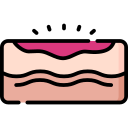These are lesions where a combination of pressure and moisture contribute to the tissue breakdown. They still need to be graded as pressure damage but awareness of other causes and treatments is needed.
See Pressure Ulcer Grading Tool.
test announcement

Skin damage due to problems with moisture can present in a number of different ways. This tool aims to help you identify the cause to aid in decision making for treatments.
Moisture may be present on the skin due to incontinence (urinary and faecal), perspiration, wound exudate or other body fluids e.g. lochia, amniotic fluid.
Lesions caused by moisture alone should not be classified as pressure ulcers.
These are lesions where a combination of pressure and moisture contribute to the tissue breakdown. They still need to be graded as pressure damage but awareness of other causes and treatments is needed.
See Pressure Ulcer Grading Tool.
Mild
Erythema (redness) of skin only. No broken areas present.

Moderate
Erythema (redness), with less than 50% broken skin. Oozing and/or bleeding may be present.

Severe
Erythema (redness), with more than 50% broken skin. Oozing and/or bleeding may be present.

Treatment
Prevention/Mild IRD
Cleanse skin e.g. foam cleanser or pH balanced product. Apply Moisturiser +/or skin protectant e.g. barrier cream/film which does not affect absorbency of continence products.
Moderate-Severe IRD
Cleanse skin e.g. foam cleanser or pH balanced product. Apply liquid/spray skin protectant, OR barrier preparation, if no improvement refer to local guidelines or seek specialist advice.
NB: Observe for signs of skin infection, e.g. candidiasis, and treat accordingly (do not use barrier films as this will reduce effectiveness of treatment).
Location

Shape

Edges

Necrosis

Depth

Colour
